Review: Justice League of America #29
By Jonathan Edwards
As singer and songwriter Adele once wrote and sang, “this is the end.” In this case, it’s the end of a long, at times bleak, trek of a comic titled Justice League of America. I remember being really excited when first hearing about the book, its interesting cast of characters, and all of the possibilities that came with them. And, the first four Rebirth one-shots, focusing on The Atom, Vixen, The Ray, and Killer Frost, respectively, were all promising prequel tie-ins that each built up more and more hype for the main book. Then, Justice League of America: Rebirth #1 came out, and it was different. Everything suddenly felt less thought-out and put together and more superficial and contrived. However, this wasn’t an isolated incident. Justice League of America issues #1 through #4 followed the trend with a weak and irritating first story arc, and things only went further downhill as the series continued. Slightly over a year later and here we are with Justice League of America #29. And, long story short, the conclusion to “Dawn of Time” sucks, but the series finale afterward is marginally better.
Okay, so, JLA #28 ended with Chronos producing Danny the Brick and using him to kill Ahl, God of Superheroes. And, now that Doom Patrol #11 is finally out, it turns out that Ahl’s only weakness is, in fact, a “brick that could think,” and the Disappointment only tracked down Danny after learning that. So, yes, I will retract my previous criticism regarding the inclusion of Danny. Although, what I won’t retract is all of my other criticisms regarding the inclusion of Ahl and Orlando’s piss-poor justification for it. Anyway, this issue picks up immediately after Ahl’s death and, for some reason, starts from Aztek’s perspective. An enraged Chronos questions how the JLA could still exist after the elimination of their forerunner. Now, Aztek did already explain in issue #27 that her suit’s 4-D energy battery disrupts the time manipulation capabilities of Chronos’s tech, and she states here that it apparently also protects them from the effects of his hourglass. However, the death of Ahl is a change to the actual timeline and not predicated upon the function of his hourglass at all. Yet, the real question is why Chronos doesn’t just leave right after hearing that. Seriously, he succeeded in killing the God of Superheroes, so why doesn’t he go back to the future and leave the JLA stranded in prehistory? There is zero reason for him to stay other than to get beaten by Ryan in a manner far too convenient given the amount of power he’s exhibited throughout this story arc and how quickly he dispatched The Atom last issue. Additionally, I was also wrong about another hero making the imprint. And, while the actual solution does make sense, it also feels sort of uninspired and lazy.
Lobo makes a brief and forced reappearance at the beginning of the finale. Orlando also reveals what Promethea told Caitlin at the end of “Deadly Fable,” and I wish he didn’t. I mean, yeah, props to him for finally showing rather than telling, but it was more interesting when we didn’t know what Promethea said, especially because it turns out to be nothing particularly meaningful or inspiring despite trying to be both those things. Finally, Justice League of America ends with a press conference, and… it’s a mixed bag. On the one hand, I think it does give us a relatively clear look into the heart of what Orlando wanted to do with this book, even if he never succeeded at structuring a story around it. But, on the other, it’s a bit of a cop out and kind of a slap in the face to the significance and legacy of the name Justice League of America.
Hugo Petrus returns one last time for the final art duties, and my feelings about him remain ultimately unchanged from my reviews of the last two issues. Admittedly, there are a few panels that work pretty well, but there are also moments where at least Crazy Jane, Promethea, Lobo, Killer Frost, Black Canary, and Vixen are all uncomfortably off-model.
And, with that, Justice League of America #29 and the series comes to a close. Will there be a follow-up? Maybe. Steve Orlando certainly seems to want one enough to set it up here, but who knows if DC will actually see it through. In conclusion, as much as I wish I could say it was a pleasure reviewing all five prequel one-shots, twenty-nine issues, and the one annual of Justice League of America, it really wasn’t. But, it is something I felt uniquely obligated to commit to. As such, I don’t think my work will be completely done until I tackle a certain five-issue crossover event when its trade is released in June. Spoiler: it’s Milk Wars.
Score: 2/5
Justice League of America #29
DC Comics


